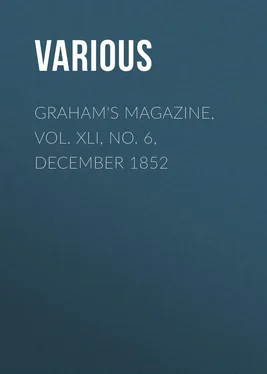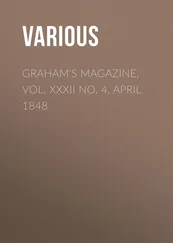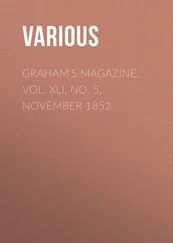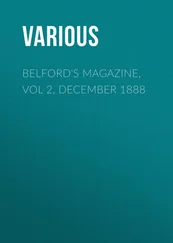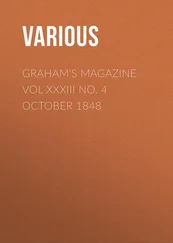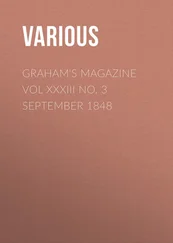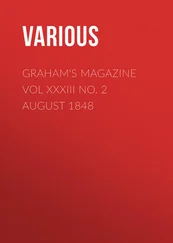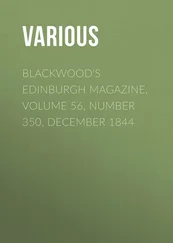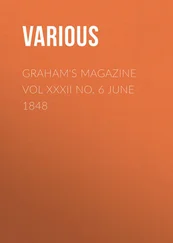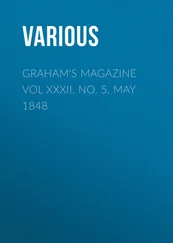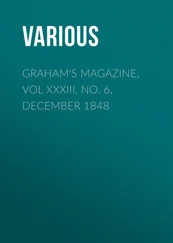Various - Graham's Magazine, Vol. XLI, No. 6, December 1852
Здесь есть возможность читать онлайн «Various - Graham's Magazine, Vol. XLI, No. 6, December 1852» — ознакомительный отрывок электронной книги совершенно бесплатно, а после прочтения отрывка купить полную версию. В некоторых случаях можно слушать аудио, скачать через торрент в формате fb2 и присутствует краткое содержание. Издательство: Иностранный паблик, Жанр: periodic, literature_19, foreign_edu, на английском языке. Описание произведения, (предисловие) а так же отзывы посетителей доступны на портале библиотеки ЛибКат.
- Название:Graham's Magazine, Vol. XLI, No. 6, December 1852
- Автор:
- Издательство:Иностранный паблик
- Жанр:
- Год:неизвестен
- ISBN:нет данных
- Рейтинг книги:3 / 5. Голосов: 1
-
Избранное:Добавить в избранное
- Отзывы:
-
Ваша оценка:
- 60
- 1
- 2
- 3
- 4
- 5
Graham's Magazine, Vol. XLI, No. 6, December 1852: краткое содержание, описание и аннотация
Предлагаем к чтению аннотацию, описание, краткое содержание или предисловие (зависит от того, что написал сам автор книги «Graham's Magazine, Vol. XLI, No. 6, December 1852»). Если вы не нашли необходимую информацию о книге — напишите в комментариях, мы постараемся отыскать её.
Graham's Magazine, Vol. XLI, No. 6, December 1852 — читать онлайн ознакомительный отрывок
Ниже представлен текст книги, разбитый по страницам. Система сохранения места последней прочитанной страницы, позволяет с удобством читать онлайн бесплатно книгу «Graham's Magazine, Vol. XLI, No. 6, December 1852», без необходимости каждый раз заново искать на чём Вы остановились. Поставьте закладку, и сможете в любой момент перейти на страницу, на которой закончили чтение.
Интервал:
Закладка:
Various
Graham's Magazine, Vol. XLI, No. 6, December 1852
“PALE CONCLUDING WINTER.”
With howling fury Winter makes his bound
Upon us, freezing Nature at a look.
He dashes out the sweet and dreamy hues
Of Indian Summer, so that where the eye
The golden softness and the purple haze
Beheld at noon, at sunset sees the mist
Darken around the landscape, and the ear,
Nestling upon its pillow, hears the sleet
Ticking against the casement, whilst within
The silvery cracking of the kindling coal
Keeps merry chime. The morning rises up,
And lo! the dazzling picture! Every tree
Seems carved from steel, the silent hills are helm’d,
And the broad fields have breastplates. Over all
The sunshine flashes in a keen white blaze
Of splendor, searing eyesight. Go abroad!
The branches yield crisp cracklings, now and then
Sending a shower of rattling diamonds down
On the mailed earth, as freshens the light wind.
The hemlock is a stooping bower of ice,
And the oak seems as though a fairy’s wand
Had, the past night, transformed its skeleton frame
To a rich structure, trembling o’er with tints
Of rainbow beauty… A. B. Street.
A HISTORY OF THE ART OF WOOD-ENGRAVING
With regard to the antiquity and origin of this most beautiful and most important of the early Christian arts – most important, because to it can be traced directly the invention of typography, as it now exists, bringing knowledge and truth within the reach of all who desire to attain them – there has been much difference and dispute among the literati. After the second restoration of letters – I mean after the dull and dreary interregnum between the era of the Stuarts and the Georgian era of literature, dating from the commencement of the present century – there seems to have arisen a strange habit of referring every thing, the origin of which was not distinctly known, to eras the most remote. Not to be able to say such a discovery was made by such a learned German or Venetian, by such a celebrated Gaul or Briton, in such a town, in such a year, of such a century, was sufficient cause for the drivelers of the time – the best scholars of whom knew, like Shakspeare, little Latin and less Greek, assuming, nevertheless, the possession of the deepest classic lore – to assert point-blank that it was made by such a wonderful Chinese philosopher during the reign of Wu-wang, emperor of China, or such a remarkable Egyptian sage, in the reign of Tathrak or Amenophis; or, that it was in common use in the days of Pericles, or perhaps even of the later Roman emperors.
The general knowledge of the classic languages was then so rare even among the authors of those days, that the dictum of any dunce who grossly misconstrued a Greek or Latin text, or of any rogue, who chose to forge one in support of his theory – in those days a matter of daily occurrence – was, so far from being questioned, detected, refuted, and exposed, as would now be the case, within a week of its publication, quoted and requoted by successive schools of dunces, until it was received as a truth, and sent down as a grave authority to future generations.
Though no author of this day, thanks to the number and acumen of the literary and critical journals – we do not mean newspapers, which promulgate, not correct falsehoods – could originate a blunder, much less a forgery, with a possibility of escaping detection; still, careless and hasty compilers following what they deem authorities, without themselves referring to the original authority cited, are constantly reproducing falsehood, promulgating it, and giving to it weight as truth, when nothing is more averse from their intention than to do so.
In nothing is this more the case than in the very class of works in which of all others accuracy and truth are most requisite – are, indeed, indispensable – we mean what are now called juvenile books, school-books for the use of the young. These works are, unfortunately, rarely or never composed by men of science, men of historical knowledge, men of high general information, or literary standing, although – embracing, as they pretend to do, the whole range of human knowledge from astronomy and the direct sciences, through universal history to political economy, physical and moral philosophy, and philology – they, above all beside, should be the work of men of unerring accuracy in the statement of facts. Since it is easier to teach three new ideas to a mind unimpressed, than to eradicate from it one preconceived opinion, false or true.
It is enough to say in this connection, that out of all the modern “histories for the young” we have ever seen – and we have seen scores, if not hundreds – we never read six successive pages which did not contain either a disgraceful blunder as to fact, or a more disgraceful perversion of facts to meet popular prejudices or popular passions. In the pseudoscientific text-books, sheer stupidity and ignorance produce the same effects.
All this class of books, as a rule, are worse than worthless; and we had far rather see the rising generation return to “Mother Goose,” “Little Red Riding Hood,” and “Cinderella,” and thence to “Sandford and Merton,” Mrs. Barbauld, Miss Edgeworth, and works and writers of the like calibre, until fit to commence the real study of real history and real science, than have them stuffed with such farragoes of imbecility, reckless assertion, and plausible falsehood – under the plea of knowledge made popular – as, for instance, most of “The Histories for the Young,” which afford a perfect type of the class of works, to which we have just alluded.
To this train of thought we have been led, by observing the pertinacious and absurd folly, on the part of all the writers on the subject before us, of ascribing the art of wood-engraving and printing, to every nation which never possessed it, and the invention of it to none knows who.
It really seems that to these worthies it is quite argument enough to say, because the Chinese, Egyptians, Phœnicians, Greeks, or Romans did not possess such an art, but did possess such another, therefore they must have possessed that which they did not possess.
Thus – because the Egyptians made wooden moulds with reversed characters or figures, wherein to make fictile bricks, jars, or other implements – they possessed the art of wood-engraving and printing.
Because the Greeks and Romans used to engrave their laws and decrees on stone or metal, both in intaglio and relief, and even colored the depressed or prominent characters with various pigments, therefore the Greeks and Romans made use of printing and wood or metallic engraving – as understood in the present sense; that is to say, for the purpose of taking reversed impressions on paper, parchment, or the like, with ink or other pigments, from prepared blocks, or forms of movable types – the impressions, not the blocks or forms, being legible in the usual mode, from left to right, or the reverse, according to the nature of the character or language.
It is, perhaps, scarcely necessary now to state, not only that there is no reason for believing that any ancient nation was acquainted at all with any thing in the least degree approaching to the modern art of printing, but that there is a positive certainty that no people of antiquity was so acquainted.
In the same manner may be dismissed the Chinese claim to originality in this invention. So early as the 12th century, stamps, engraved with monograms, or fanciful figures, assumed by individuals as their signs manuals, wrought on them in relief, were in common use. They were made of wood or metal, dipped in ink or paint, and impressed on any document requiring signature; and they seem to have continued occasionally in use so late as to the reign of King Henry VIII. of England, whose warrant for the execution of the poet Surrey was signed by this method, and not by royal sign manual; the king being then in articulo mortis , and unable to sign his name.
Читать дальшеИнтервал:
Закладка:
Похожие книги на «Graham's Magazine, Vol. XLI, No. 6, December 1852»
Представляем Вашему вниманию похожие книги на «Graham's Magazine, Vol. XLI, No. 6, December 1852» списком для выбора. Мы отобрали схожую по названию и смыслу литературу в надежде предоставить читателям больше вариантов отыскать новые, интересные, ещё непрочитанные произведения.
Обсуждение, отзывы о книге «Graham's Magazine, Vol. XLI, No. 6, December 1852» и просто собственные мнения читателей. Оставьте ваши комментарии, напишите, что Вы думаете о произведении, его смысле или главных героях. Укажите что конкретно понравилось, а что нет, и почему Вы так считаете.
